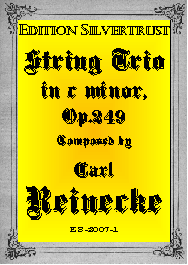Presents
Carl Reinecke
String Trio in c minor, Op.249 for Violin, Viola & Cello
 At the age of 74,
Carl Reinecke (1824-1910) wrote what is arguably the greatest late romantic
string trio.
At the age of 74,
Carl Reinecke (1824-1910) wrote what is arguably the greatest late romantic
string trio.
Nowadays, Reinecke has been all but forgotten, an unjust fate for a man who excelled in virtually every musical field with which he was involved. As a performer, Reinecke was, during the mid-19th century, reckoned for three decades as one of the finest concert pianists before the public. As a composer, he produced widely respected and often performed works in every genre running the gamut from opera, to orchestral to chamber music. As a conductor, he helped turn the Leipzig Gewandhaus Orchestra into a group with few if any peers. As its director, he helped the Leipzig Conservatory become what was widely regarded as the finest in the world. As a teacher of composition and of piano, he was considered to have few if any equals. Among his many students were Grieg, Bruch, Janacek, Albeniz, Sinding, Svendsen, Reznicek, Delius, Arthur Sullivan, George Chadwick, Ethel Smyth, Felix Weingartner, Karl Muck and Hugo Riemann. In his time, Reinecke and his music were unquestionably regarded as first rate.
Reinecke was born near Hamburg in the town of Altona, then in the possession of Denmark. Most of his musical training was obtained from his father, who was a widely respected teacher and author. Starting in 1845 at the age 21, he began concertizing across Europe, in the course of which he was appointed court pianist to the King of Denmark. Mendelssohn, Schumann and Liszt all were favorably impressed by him and helped him gain an appointment at the Cologne Conservatory. By 1860, Reinecke’s reputation was such that he obtained a teaching position at the prestigious Leipzig Conservatory, which had been founded by Mendelssohn, and eventually rose to become its director. His reputation and excellence as a teacher can be attested to by the aforementioned list of famous students.
Unlike many of his contemporaries, or even some of those composers who were younger such as Bruch, Reinecke was able to move beyond the music of Mendelssohn and Schumann, the musical idols of the mid 19 Century. This string trio is infused with the developments of late, and even Post-Brahmsian, romanticism. The writing is very contrapuntal and original. The dark and brooding opening Allegro moderato is painted on a large canvas. It shows a wide range of emotion and richness of tonality, Reinecke easily and often makes the three voices sound like four. The Andante which follows is a theme and set of variations. It is more intimate and trio-like than the preceding movement, beginning with a naive, quiet melody. Our sound-bite is of the energetic, dance-like fourth variation. The very brief third movement, Intermezzo, Vivace ma non troppo, is a heavily syncopated scherzo with an interestingly contrasting middle section which illustrates Reinecke employing the new directions of Post-Brahmsian tonality. The big finale, Adagio, ma non troppo lento,—Allegro un poco maestoso, begins as a lyrical and highly romantic lied. It has a valdictory quality to it. The thematic material of the Allegro is brighter but still densely scored, once again creating a wealth of sound which belies the fact that only a trio is playing. (Our sound-bite begins at the very end of the Adagio)
This is a superb masterpiece which should be on the music stands of every string trio group, whether amateur or professional. Long out of print, we are very pleased to be able to make this fine work available again.
Parts: $19.95
Parts & Score: $29.95